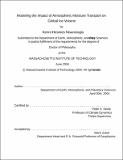Modeling the impact of atmospheric moisture transport on global ice volume
Author(s)
Nisancioglu, Kerim Hestnes, 1975-
DownloadFull printable version (3.219Mb)
Other Contributors
Massachusetts Institute of Technology. Dept. of Earth, Atmospheric, and Planetary Sciences.
Advisor
Peter H. Stone.
Terms of use
Metadata
Show full item recordAbstract
Following Milankovitch's original hypothesis most model studies of changes in global ice volume on orbital time scales have focused on the impact of ablation on ice sheet mass balance. In most cases, poleward moisture flux is fixed and accumulation of snow only depends on local temperature. In this study, a simple coupled atmosphere-ice process model is introduced. An improved representation of the atmospheric hydrological cycle is included, and accumulation is related to the meridional flux of moisture by large scale baroclinic eddies. The ice sheets in the Northern Hemisphere respond to both precession and obliquity frequencies when the model is forced with seasonal insolation. Obliquity variations are introduced by the impact of earth's tilt on the meridional temperature gradient and the poleward flux of moisture, whereas precession governs surface melting by regulating summer temperatures. The response of the ice sheet to obliquity and precession is comparable, and significantly smaller than what is observed in the oxygen isotope record of the late Pliocene and early Pleistocene (2.7 - 0.8 Ma BP). This suggests that in order to successfully reproduce the strong 41 Ka periodicity observed in the record, other mechanisms must be involved such as nonlinear self-sustained, or stochastic processes, or alternatively the obliquity dominated signal originates from Antarctica. In Antarctica the seasonal cycle is damped due to the large thermal mass of the southern ocean, and surface melt is insignificant. Both of these factors reduce the influence of precession in regulating ice volume. Instead, the mass balance is dominated by accumulation and calving, thereby enhancing the role of obliquity in controlling ice volume.
Description
Thesis (Ph. D.)--Massachusetts Institute of Technology, Dept. of Earth, Atmospheric, and Planetary Sciences, 2004. Includes bibliographical references (leaves 137-154). This electronic version was submitted by the student author. The certified thesis is available in the Institute Archives and Special Collections.
Date issued
2004Department
Massachusetts Institute of Technology. Department of Earth, Atmospheric, and Planetary SciencesPublisher
Massachusetts Institute of Technology
Keywords
Earth, Atmospheric, and Planetary Sciences.